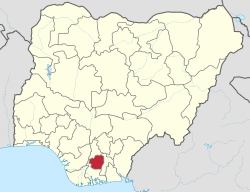INTRODUCTION
Imo State is one of the five states that make up Nigeria’s South-East geopolitical zone. It shares borders with Rivers State to the South, Abia State to the East and Northeast, and Anambra State to the West and Northwest. The state capital is Owerri.
LANDMASS, LOCATION, AND POPULATION
Imo State covers an area of 5,542 square kilometres. It lies at latitude 5°29’ North and longitude 7°2’ East. It has a population of 3,927,563 (2006 census) 5,408,756 (2016 forecast) and a population density of 708. The state accounts for 2.8% of Nigeria's total population.
HISTORY AND PEOPLE
Imo State is named for the Imo River which flows through the state. Its inhabitants are chiefly Igbos.
Imo was originally part of the Eastern Region in the three-region structure of 1954. In 1967, with the creation of 12 states by the military administration of General Yakubu Gowon, it became a part of East Central State.
In 1976, when the military administration of General Murtala Muhammed created 19 states out of the existing 12, East Central State was divided into Anambra and Imo States. In 1991, the military administration of General Ibrahim Babangida carved Abia State out of Imo State.
MAIN TOWNS AND CITIES
Owerri (capital), Agu, Ideato, Mbaise, Mbieri, Mgbidi, Njaba, Nkwerre, Oguta, Okigwe, Orlu, Orodo, and Orsu.
LOCAL GOVERNMENT AREAS
ADMINISTRATORS AND GOVERNORS
Ndubisi Kanu (Governor – Military): March 1976 – 1977
Adekunle Lawal (Governor – Military): 1977 – July 1978
SundayAdenihun (Governor – Military): July 1978 – October 1979
Samuel Mbakwe (Governor – Civilian (Nigerian People’s Party)): October 1979 – December 1983
Ike Nwachukwu (Governor – Military): January 1984 – August 1985
Allison Madueke (Governor – Military): August 1985 – August 1986
Amadi Ikwechegh (Governor – Military): August 1986 – August 1990
Anthony Oguguo (Governor – Military): August 1990 – January 1992
Evan Enwerem (Governor – Civilian (National Republican Convention)): January 1992 – November 1993
James Aneke (Administrator – Military): December 1993 – August 1996
Tanko Zubairu (Administrator – Military): August 1996 – May 1999
Achike Udenwa (Governor – Civilian (People’s Democratic Party)): May 1999 – May 2007
Ikedi Ohakim (Governor – Civilian (Progressive People’s Alliance/People’s Democratic Party)): May 2007 – May 2011
Rochas Okorocha (Governor – Civilian (All Progressives Grand Alliance/All Progressives Congress)): May 2011 – May 2019
Emeka Ihedioha (Civilian – People’s Democratic Party): May 2019 – February 2020
Hope Uzodinma (Civilian – All Progressives Congress): February 2020 – Present
ECONOMY AND EDUCATION
Imo State is mostly tropical rain forest with some areas of forest swamp towards its extreme western border. The state’s high population density has resulted in the loss of a large amount of its original forest areas. Agriculture is important in the state and most of its workers are engaged in it.
Rubber, mahogany, bamboo, iroko and obeche are cultivated for export markets. Other cash crops in the state are oil and raffia palm, rice, corn, cocoa, groundnut, and cotton. Crops cultivated for domestic markets include yams, cocoyams, corn, melon and cassava. Important minerals in Imo State are petroleum, natural gas, limestone, kaolin, zinc, lead, marble, iron ore, salt, granite, quartz and industrial sand. Industrial activity in the state relate mainly to construction and mining sectors.
The tertiary institutions in Imo State are Federal University of Technology, Owerri; Imo State University, Owerri; Federal polytechnic, Nekede; Federal College of Land Resources Technology, Owerri; Imo State Polytechnic, Umuagwo and Alvan Ikokwu Federal College of Education, Owerri.
FAMOUS SITES AND CULTURE
Sites
Ndubuisi Kanu Heroes Square, Owerri
Ndubuisi Kanu Heroes Square in the heart of Owerri consists of large statues of Nigerian and other African leaders . Odumegwu Ojukwu, Nnamdi Azikiwe, Akanu Ibiam, Samuel Mbakwe, Abubakar Tafawa Balewa, Olusegun Obasanjo, Ghana’s Nana Akufo-Addo and Kwame Nkrumah, Liberia’s Ellen Johnson- Sirleaf and South Africa’s Jacob Zuma are some of the personalities represented by the statues.
Mbari Cultural Centre, Owerri
Mbari is a virtual art form practised in early years by the Igbos. The centre is an open air museum hosting artefacts and other relics on the history and heritage of Igboland.
Ngwu Spring Water, Ngwu
Ngwu Spring Water is a natural spring in Nkwere local government area. The spring is regarded as mysterious because it flows without ceasing and unlike other water bodies, its volume increases during the dry season.
Culture
Imo State is home of several festivals and cultural activities with the Iri-ji Oru or New Yam festival regarded as one of the most important.
The festival brings agrarian communities and other farming groups together every year to mark the eating of new yam.
Ahiajoku is a cultural festival held annually to honour the god of yam and cocoyam while Abigbo and Ekere-Avu dances were used by the people of Mbaise in previous years as platforms for social criticism.
Other cultural activities include Ibo Uzo festival and Oghu festival.
NOTABLE INDIGENES
Dr. K.O. Mbadiwe (1915–1990)
Flora Nwapa (1931 – 1993)
DID YOU KNOW
The Ikeji Festival of Arondizuogu is regarded as the greatest carnival of masks and masquerades in Africa.
IMO STATE IN PICTURES

